

Life in Anglo Saxon England. Everyday life in Anglo Saxon England was hard and rough even for the rich.
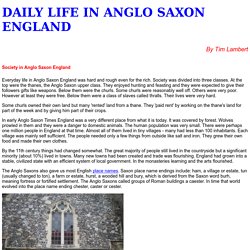
Society was divided into three classes. At the top were the thanes, the Anglo Saxon upper class. They enjoyed hunting and feasting and they were expected to give their followers gifts like weapons. Below them were the churls. Some churls were reasonably well off. Some churls owned their own land but many 'rented' land from a thane.
In early Anglo Saxon Times England was a very different place from what it is today. By the 11th century things had changed somewhat. The Anglo Saxons also gave us most English place names. A Saxon church in Chichester Kinship (family ties) were very important in Anglo Saxon society. At first Anglo Saxon society was relatively free. Anglo Saxon Music 600-1100. Anglo Saxon Music 500-1066 Jessica Lovett copyright 2000 Unlike its current trivial place in today's society, in the early middle ages music was a valued part of the four sciences, or quadrivium.
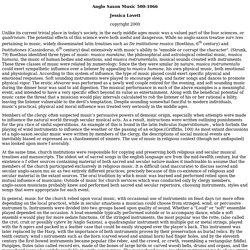
The potential effects of this science were both useful and dangerous. While no anglo-saxon treatise surv ives pertaining to music, widely disseminated latin treatises such as De institutione musica (Boethius, 6th century) and Institutiones (Cassiodorus, 6th century) deal extensively with music’s ability to "ennoble or corrupt the character". Members of the clergy often suspected music’s persuasive powers of demonic origin, especially when attempts were made to influence the natural world through secular musical acts. At the same time, church institutions were responsible for copying and preserving both religious and secular musical treatises and manuscripts.
Music occupied a unique position for the Anglo Saxon – it was both an entertainment, and a danger, a tool, and a potential weapon. The Viking Invasions of England - 793 AD to 900 AD. The Viking Invasions of England - 793 AD to 900 AD The Age of the Vikings As we have learned in the first part of this History of the English, our early ancestors came to this Island, first as raiders and some as mercenaries, invited by a Romanic British Warlord (Vortigern,) to fight the Picts of the North but who later turned on their Romanic-British paymasters, and turned from mere raiders to conquers who would form the beginning of a New England.
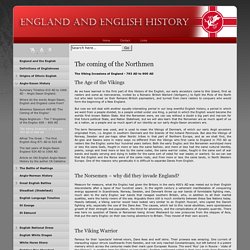
But now we will deal with another equally interesting period in our long eventful English history, a period in which we went from a people divided, to a people united under one King, a period in which the English would become the worlds first known Nation State. The term Norsemen was used, and is used to mean the Vikings of Denmark, of which our early Angli ancestors originated from, i.e. Ashmolean Museum: Anglo-Saxon Discovery - Weapons. Tha Engliscan Gesithas.
Anglo-Saxon Families The father was the head of the family in Anglo-Saxon England, and the spear propped up by the door symbolised his role as protector.
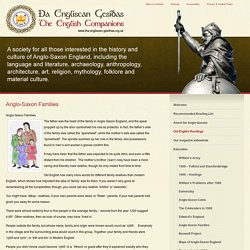
In fact, the father’s side of the family was called the ‘sperehealf’, while the mother’s side was called the ‘spinelhealf’. The spindle summed up her role in the family, and possessions found in men’s and women’s graves confirm this. It may have been that the father was expected to be quite strict, and even a little distant from his children. The mother’s brother (‘eam’) may have been a more caring and friendly male relative, though he only visited from time to time. Old English has many more words for different family relatives than modern English, which shows how important the idea of ‘family’ was for them. You might have ‘stēop-‘ relatives, if your own parents were dead, or ‘fōster-‘ parents, if your real parents had given you away for some reason. Ashmolean Museum: Anglo-Saxon Discovery - Houses.
Ashmolean Museum: Anglo-Saxon Discovery - Beliefs. When did the Anglo-Saxons become christians?
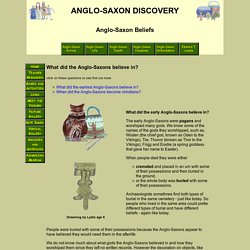
When the Romans left, just after AD400, there were still some christians in Britain, but when the Anglo-Saxons arrived most people appear to have become pagans. Archaeologists can tell this from the types of burials, since pagans buried people with their possessions but christians did not. The christian church in Rome sent a monk called Augustine to England in AD597 to convert the Anglo-Saxons to christianity. He arrived in Kent and persuaded the King of Kent to become a christian. Augustine then built a church at Canterbury. History - Anglo-Saxon Law and Order. Angelcynn - Clothing and Appearance of the Pagan Anglo-Saxons.
We have very little direct evidence of the clothing of the early 'Anglo-Saxons', as the surviving textiles are only fragmentary (usually in a mineralised form on metal artefacts) and there is little or no pictorial or literary evidence from this country.
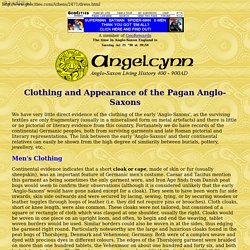
Fortunately we do have records of the continental Germanic peoples, both from surviving garments and late Roman pictorial and literary representations. The link between the early 'Anglo-Saxons' and their continental relatives can easily be shown from the high degree of similarity between burials, pottery, jewellery, etc..Men's ClothingContinental evidence indicates that a short cloak or cape, made of skin or fur (usually sheepskin), was an important feature of Germanic men's costume.
Open topped sandals of the type found in Danish and Germam peat bogs and early Germanic graves. This type of footwear would also have been worn by some of the early Anglo-Saxons (Click on image for a closer look) Anglo-Saxon Food. Fish When the Romans invaded Greece, they were first introduced to seafish, which they before had never consumed because they were mostly inland farmers.
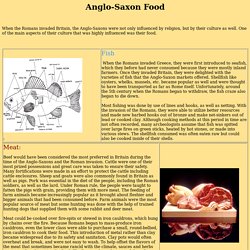
Once they invaded Britain, they were delighted with the varieties of fish that the Anglo-Saxon markets offered. Shellfish like oysters, whelks, mussels, etc. became popular as well and were thought to have been transported as far as Rome itself. Unfortunately, around the 5th century when the Romans began to withdraw, the fish craze also began to die down.
Most fishing was done by use of lines and hooks, as well as netting.